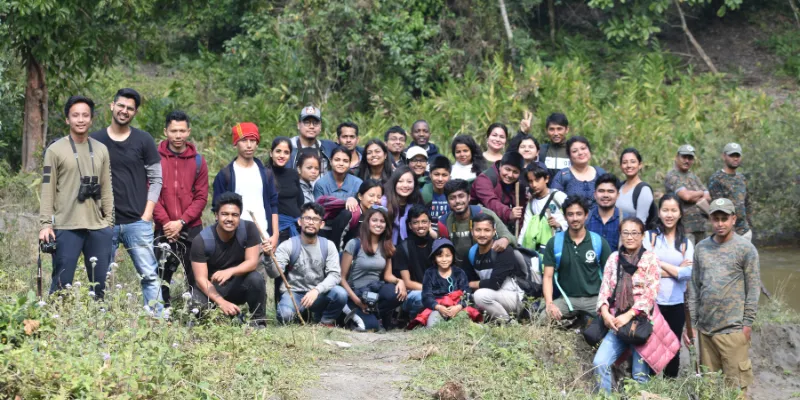How this organisation is using Naturenomics to uplift livelihoods in the eastern Himalayas
Founded by Prabir Banerjea and Ranjit Barthakur in 2007, Balipara Foundation is preserving the natural habitats in the eastern Himalayas by engaging local communities in activities like afforestation and agroforestry.
Characterised by woodland canopies, breathtaking valleys, lush green sal forests, and a wide variety of flora and fauna, the eastern Himalayas is one of the most panoramic regions on the planet. It stretches from Nepal in the west, to the Northeastern states of India, all the way up to the Tibetan plateau, Myanmar’s western areas, China’s mountains, as well as Bhutan, and Bangladesh in the east.
However, this vast landscape has been under threat for many years now. Deforestation, poaching, and development of hydropower projects are not only leading to the destruction of habitats but are also depriving the indigenous residents of their livelihood.

The eastern Himalayan region has been under a threat due to deforestation.
According to a report published on IntechOpen, the Himalayan landscape is undergoing significant degradation, which is taking a toll on crops and the human-wildlife harmony. The research also points out that, every year, about 20 elephants and 50 localities lose their lives in these mountainous areas.
In fact, if deforestation in the Himalayas continues at the present rate, by 2100, the forest cover will be restricted to 10 percent of the land area, the report states. This trend will likely result in the extinction of 366 plants and 35 vertebrates native to the region.
Prabir Banerjea and Ranjit Barthakur — who were disquieted by the ecological deterioration in the belt — decided to launch Balipara Foundation in 2007. The duo started by establishing a small eco-tourism project called Wild Mahseer in Assam, and subsequently, branched out by taking a community-centric approach to conserving natural ecosystems in the eastern Himalayas.

The Naturenomics school.
Today, Balipara’s team of 42 people engage the local communities in activities like afforestation, sustainable housing, agro-forestry, and documentation of biological resources. Through its unique concept of Naturenomics (nature + economics), the foundation is also equipping them to earn a sustainable livelihood.
“Both Ranjit and I have our roots in Assam. But, when we found out that over two million trees had been cut in the eastern Himalayans for commercial purposes in three years, we were astonished. We really wanted to do something about it,” Prabir Banerjea, Co-founder and Managing Member, Balipara Foundation tells SocialStory.
An endeavour to conserve natural habitats
Ranjit and Prabir first met each other in primary school. At the time, both their parents were tea planters. The duo later re-connected in 1980 and made it a point to keep in touch thereafter.
Before starting Balipara, Ranjit worked as an advisor to the former Chief Minister of Assam and led teams at companies such as Tata Tea, Hutchison Max-Touch (Vodafone), and more. He also serves on the boards of multiple NGOs, including Ashoka Trust for Research and Ecology, the Northeast Initiative Development Agency, and Myanmar Institute of Information Technology, among others.
Prabir, on the other hand, worked with a few multinational firms for two years. Immediately after, he jumped onto putting his efforts to co-create and implement conservation and social restoration projects as part of the foundation.

Ranjit Barthakur (left) and Prabir Banerjea (right), Co-founders, Balipara Foundation.
“In 2005, we began sharing our common interest to give back to the homeland and its ethnic tribes. That is how the Balipara Foundation was born two years after,” recalls Prabir.
One of the first large-scale initiatives of the NGO was the Eastern Himalayan Botanic Ark. Commenced in 2016, the initiative involved training indigenous communities to procure and nurture seeds from the nursery, plant saplings, and finally, revive the decimated green cover for Asian elephants. The conservation activities under the project rebuilt habitats for over 300 plants and 75 bird species.
“The Mishing, Garo, Assamese, and Nyishi communities, with whom we collaborated, were powerhouses of knowledge. They already had a deep understanding of the landscape, biodiversity, and the various species of plants and animals. Hence, there was not much of a hassle to involve them in the reforestation plan,” explains Saurav, Lead Architect and Designer of Rural Futures, Balipara Foundation.

One of the women from the indigenous communities planting a sapling.
In 2017, the foundation set up another restoration project in the Udalguri district of Assam, which had become the hub of human-elephant conflict, owing to the degeneration of forests. The initiative brought together 29 different local communities who organised themselves to plant trees at the Bhairabkunda Reserve Forest, which was destroyed by the 1989 flash floods.
At the end of the second phase of the project, it was observed that the programme had given rise to over four lakh natural assets, including trees.
“About 10,000 individuals and tribes living in the fringes of these forests were struggling to earn regular incomes because of extreme weather conditions, and the overall agrarian distress in the region. Hence, we came up with the concept of Naturenomics, where we facilitated local people to harvest from the plants they had sown,” notes Saurav.

Saurav Malhotra, Lead Architect and Designer of Rural Futures, Balipara Foundation.
Balipara Foundation helped the indigenous youth to harvest and sell many items such as moringa, ginger, turmeric, lemon, mushroom, chilly, papaya, and other fruits, as well as berries. Due to the pre-existing demand for the produce in the neighbourhood areas, the tribes sold them in these places, thereby creating an income of Rs 70 lakh.
The success of the Udalguri initiative, gave the foundation the impetus to kick off The Balipara Reserve Forest Project in 2018 — a drive to create incomes and better standards of living for the communities through agroforestry (a combination of agriculture and forestry).
Several studies have highlighted the economic and environmental benefits of planting trees and shrubs around crops and pastures — firstly, it enables individuals to reap a wide range of marketable produce; secondly, it helps in improving the overall quality of the soil.

Many wild mushroom varieties are preserved and harvested in the area.
“Balipara organised many training sessions for the local youth to teach them agroforestry. From planning windbreaks, implementing alley cropping, to choosing the type of trees, and watering them, we touched upon all the elements. In the last year or so, the communities have planted over 5.88 lakhs trees, and earned over Rs 1 crore from it,” says Saurav.
Besides these projects, the foundation consistently collaborates with the Himalayan communities to chronicle diverse variety of plant, flower, and animal species in the forests. Presently, Balipara is hand-holding thousands of youths to discover, observe, research, and click pictures of all the bio-resources they come across to build a vast repository of knowledge, and sharing them with their future generations.
In line with this, Saurav recently launched the RuFu (Rural Futures) lab — a physical centre in Sonitpur, Assam where the locals can collaborate, learn, and experiment with agroforestry techniques, and all kinds of natural assets.

The location where the Rural Futures lab is situated.
Empowering the local youth of Himalayas
Though the head office of Balipara Foundation is located in Guwahati, Assam, its team members and volunteers are scattered across the eastern Himalayan region to oversee the implementation of programmes.
Some of the entities who have donated to the NGO's causes include the Tata Trust, HT Parekh Foundation, Axis Bank, as well as the Ministry of Science and Technology, Government of India. It has also partnered with a slew of botanists, anthropologists, and researchers to obtain expert guidance for its initiatives.

A training session being held by Balipara Foundation for the local community.
Since its inception, Balipara has helped farmers and indigenous people to increase their incomes by 40 percent, and has planted about 2.1 million trees in the region. Over 30,000 households have been positively impacted through this.
Dimbeshwar Brahma, who has been working in the Balipara Reserve Forest project since early last year, has seen an increase in his income by over 50 percent.
“We’ve seen the grave effects of deforestation in our area – reduced rainfall, decrease in fertility of our soils, and a lot of human-elephant conflicts. With the help of Balipara, I was able to restore the greenery in my area, and also push my revenue further up. By growing and selling indigenous medicinal crops, I witnessed a 50 percent increase in earnings. Now, I think, I will be able to access better healthcare and education for my family,” he claims.

Dimbeshwar Brahma, member of an indigenous tribe in the Himalayas, works as part of the Balipara Reserve Forest project.
“The Naturenomics model that we have conceptualised can be applied anywhere across the world. For the time being, we are planning to extend our work to the interiors of Brazil, Nepal, and Bhutan in the coming years,” quips Saurav.
Edited by Suman Singh








